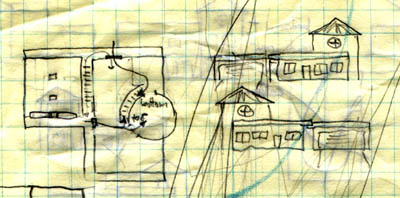
From the start I knew I wanted no cathedral ceilings, a full basement, and a quiet bedroom separate from the rest of the house. I quickly decided on RASTRA construction. I put the quiet bedroom in a tower on the second floor. I extended the tower through the first floor and basement to a subbasement to make it the most distinctive feature of the house when viewed from the outside. I wanted to hide the garage.
I've lost my earliest sketches. In those the two-car garage was in the back, tacked on to the house, hidden somewhat behind the tower, with a one-car driveway skirting the tower. The tower always had a round window and a peaked roof. The rest of the house had only one story and a flat parapeted roof. I don't know what the lot will look like, but my model lot slopes down to the backyard so the basement is at ground level in the back. The earliest floorplans had the kitchen sink looking into the garage. It took awhile to settle on the stairway hugging the outside of the tower. Other alternatives were spiral staircases in the tower, a stairway hugging the inside of the tower, a straight stairway somewhere other than the tower, and a straight stairway partially entering the tower.

The sketch above is typical of the early designs, although I've realized in it that the second floor bedroom is going to need a full bath and that bath is going to be outside of the tower. Shortly after this I realized that I should make the top of the tower accessible for astronomy and sunbathing, and replaced the peaked roof with turrets. My mom thought I was being terribly ostentatious, building myself a castle. I just thought the turrets would fit with the thick walls and round tower. OK, no turrets then, go Victorian and use those fences they use in playground play structures.

Here I had the garage separate from the house, with the roof connecting them, plus a 3-foot to 5-foot overhang forming a porch and allowing someone to walk from the garage to the house without getting wet. I looked into roof weights and realized a 3-foot overhang with a 100-pound-per-square-foot wet load was probably too much.